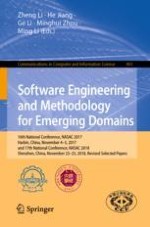2019 | Buch
Software Engineering and Methodology for Emerging Domains
16th National Conference, NASAC 2017, Harbin, China, November 4–5, 2017, and 17th National Conference, NASAC 2018, Shenzhen, China, November 23–25, 2018, Revised Selected Papers
herausgegeben von: Zheng Li, He Jiang, Ge Li, Minghui Zhou, Prof. Ming Li
Verlag: Springer Singapore
Buchreihe : Communications in Computer and Information Science
